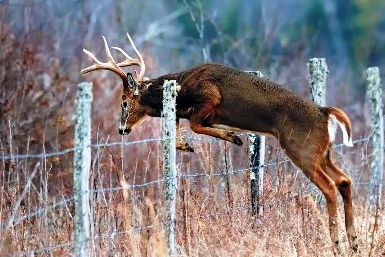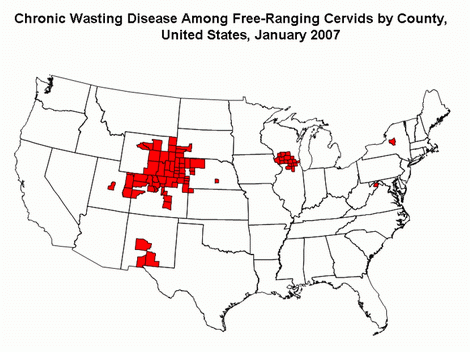State wildlife departments across the United States have continued with their annual Chronic Wasting Disease (CWD) monitoring in wild deer populations. Although numerous research studies are underway, there is currently no vaccine or other biological method of preventing CWD in a free-ranging deer herd. The only tool wildlife biologists and hunters have is to prevent the spread of CWD to new areas, because once an infected prion is deposited into the environment through either an infected carcass or from a live deer, it can remain viable for a decade or more!
Texas Parks and Wildlife Department (TPWD) wildlife biologists and technicians have continued their annual testing of tissue samples (brain stems) from hunter-harvested and road-killed white-tailed deer during the 2008-09 hunting season. To date, Texas has had no documented case of CWD within the State. Many of the samples collected over the hunting season are being prepared for analysis at the Texas Veterinary Medical Diagnostic Laboratory at Texas A&M University in College Station, Texas.
Although CWD has yet to be found in Texas, three hunter-harvested white-tailed deer in Kansas have tested positive for CWD in recent weeks according to the Kansas Department of Wildlife and Parks (KDWP). In the past few years, numerous cases of CWD have been documented in other states located in the central part of the U.S., including Oklahoma, New Mexico, Colorado, Nebraska, and Wyoming.
CWD is a progressive and fatal disease that results in small holes developing in the brain, giving it a sponge-like appearance under a microscope. Decreased brain function causes white-tailed deer, mule deer, and elk to display neurological symptoms such as depression, a droopy head, staggering, loss of appetite, and a lack of response to human disturbance. The continuing deterioration of the brain leads to other symptoms such as weight loss, drooling, and excessive thirst. If hunting in an area where CWD is known to exist, caution is advised. With that said, no human health risks have been discovered where CWD occurs.
The symptoms of CWD in deer include loss of body weight, stumbling, holding the head at an odd angle, circling, non-responsiveness to people, and pneumonia. Hunters can help protect the health of their local deer herd by taking the following steps to avoid accidentally transmitting CWD to new areas. First, do not transport deer carcasses far from the area where the deer lived, especially from areas where CWD has been detected. Secondly, if a deer carcass is transported, the hunter should make sure that carcass waste is not dumped in a location where other deer can come into contact with it. Carcass waste can also be disposed of by bagging and taking it to a landfill.


I recently culled a short tined 10 point because it looked to be a 6 1/2year old or older buck. After he was down, I found he had a real scaley fur on his face making him appear years older than he was (white scaley flakes on his brown face making it look white). The buck also had five or six 4 inch dark brown outlined cicles on his sides. His muscle tone looked poor, so I thought he was diseased and did not want this spread to other deer. After aging his lower jaw, I discovered the deer was 3 1/2 years old. Have you heard other stories like this? Is it something to be worried about?
I have a white-tail deer in my back yard that has all the symptoms of CWD. Does anyone monitor where these cases are found? I understand it is harmful to the entire deer population.
Diana, the department of natural resources, wildlife department, etc. for each state is responsible for monitoring and recording CWD cases. Contact them and explain the situation.